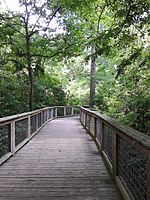Bluebonnet Swamp Nature Center facts for kids
Quick facts for kids Bluebonnet Swamp Nature Center |
|
|---|---|
| BREC's Bluebonnet Swamp Nature Center | |

Boardwalk at BREC's Bluebonnet Nature Center
|
|
| Location | Baton Rouge, Louisiana, United States |
| Nearest city | Baton Rouge, Louisiana |
| Area | 103 acres (42 ha) |
| Created | 17 May 1997 |
| Governing body | Recreation and Park Commission for the Parish of East Baton Rouge (aka "BREC") |
| Official website: http://www.brec.org/index.cfm/park/detail/19 | |
The Bluebonnet Swamp Nature Center is a cool place to explore nature! It's a big park, about 103 acres, managed by BREC (that's the Recreation and Park Commission for East Baton Rouge). You can find it in Baton Rouge, Louisiana. The center opened on May 17, 1997, and was BREC's very first park focused on nature. It's open to visitors most days for a small fee, so you can go and discover all sorts of plants and animals!
Contents
What You Can See and Do
The main building at Bluebonnet Swamp is pretty special. It's a large building with lots of interesting things to see. Inside, you'll find live animals that live in the swamp, like snakes and turtles. There are also amazing photos of the plants and animals that call the park home. You can learn about how nature works and even see some cool art. One of the coolest things is the huge collection of old duck decoys from Louisiana. These are models of ducks used by hunters!
The center also has a separate building just for learning. It's used for all sorts of educational programs.
Fun Programs and Events
There's always something happening at Bluebonnet Swamp! They have special events and programs all year long.
- Bird Walks and Talks: You can join experts to look for different birds.
- Pet Days: Sometimes you can even bring your pets!
- Toddler Sessions: Little kids can have fun learning about nature.
- Day Camps: Spend a whole day exploring the swamp.
- Art Shows: See nature-inspired art.
- Night Hikes: Explore the swamp after dark – it's a totally different experience!
They also have big yearly events:
- "Rockin' at the Swamp": This happens every March and is all about gems and minerals.
- "Duck Duck Goose Day": In August, you can learn about antique duck decoys.
- "Swamp Haunted Hikes": Get ready for some spooky fun every October for Halloween!
Exploring the Nature Preserve
The park has over a mile of trails and boardwalks. These paths take you through different kinds of forests. You'll walk through baldcypress and tupelo swamps, and also through beech-magnolia and other hardwood forests. It's a great way to see nature up close.
You'll probably spot lots of animals while you're there! Common residents include birds, squirrels, turtles, snakes, insects, and spiders. You might also see raccoons, armadillos, opossums, and swamp cottontails. If you're lucky, you could even spot foxes, coyotes, deer, or otters visiting the park.
Studying Nature
Bluebonnet Swamp Nature Center is also a place where scientists study birds. It was the main research spot for the Louisiana Bird Observatory. This group studies how bird populations change throughout the year. They also look at how birds change their feathers, which is called moulting.
Since 2010, they have been doing bird banding programs. This means they carefully catch birds, put a tiny, light band on their leg, and then let them go. This helps scientists track individual birds. They learn where birds travel and how long they live. Many students from LSU help with this research. They have learned a lot about birds like indigo buntings and Barred Owls from studying them here.

